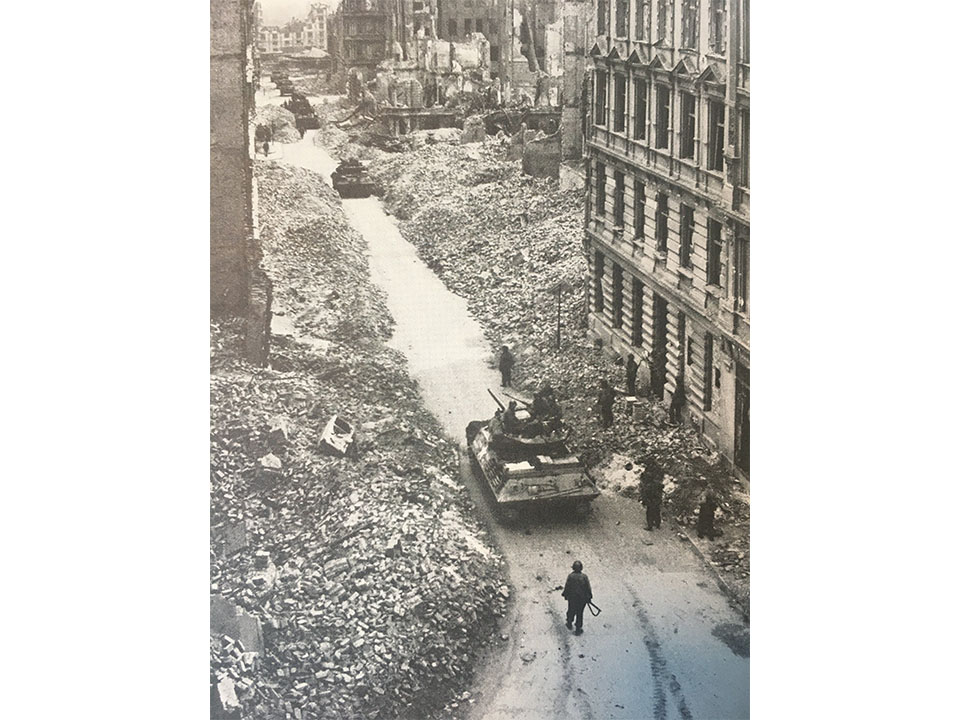In the spring of 1945, British and American forces fought their way into the heart of western Germany. Although the first German city to fall to American forces, Aachen, had been captured in October 1944, the invasion of the Third Reich began in earnest in March 1945 when the western Allies crossed the Rhine River. By the time the Nazi government unconditionally surrendered on May 8, British, French, Soviet, and American forces controlled virtually all of Germany.
American soldiers and tank destroyers make their way through the ruins of Düsseldorf. While Allied bombers had destroyed the centers of most German cities, many smaller towns escaped destruction. Courtesy of US Army.
In the seven months that American GIs fought on German soil, they formed their initial impressions of Germany, a country most soldiers previously knew only through wartime propaganda and interactions with captured German soldiers. The Germany that American soldiers saw in the spring of 1945 provoked strong reactions among their ranks and surprised them in a number of ways. The most frequently repeated observations among American soldiers were the material wealth of the country, the friendliness of civilians, and the curious absence of Nazis.
COMFORTABLE HOMES
The first thing that many American GIs noticed about Germany was its beauty. The majority of German cities, crossroads, and bridges had been destroyed by Allied bombing raids, but the bulk of Germany’s rural areas and suburbs had escaped relatively unscathed. Nineteen year old Private Richard Kingsbury of the 94th Infantry Division remembered how in southern Germany, “The frequent hills were covered with aromatic pine forests so thick with trees that they were dark and cool despite the brightest sunshine. Clear bubbling streams ran down the hills into wide lovely valleys, all intensively cultivated. The quaint little towns looked like illustrations from Grimm’s fairy tales.” Soldiers entering German houses found them richly appointed with modern furniture, paintings, china, and furs. German civilians appeared well-fed and clothed, a fact that drew frequent comments from GIs who had observed the hardships the war wrought on the populations of France and England.
Above is Kufstein am Inn and below is Kohlstoff bei Kiefersfelden. American soldiers were impressed by the beauty of the German countryside. One GI brought home these pictures which were printed as souvenirs. Images courtesy of Tyler Bamford.
Germany’s prosperity inspired anger in many American soldiers. Prior to entering Germany, GIs already resented the Germans for starting the war. After GIs saw the affluence of German homes, however, many of the conquerors became even more bitter toward German civilians. American conquerors assumed that the Germans looted much of this material abundance from countries under their dominion. In addition, Americans encountered millions of malnourished and mistreated Displaced Persons—men, women, and children who were forced to work as slaves in German factories and fields. As a result, American soldiers became more willing to destroy and loot German property. American Lieutenant Colonel James H. Polk confided to his wife that seeing the wealth of Germany made him “want to burn every town to the ground. I really want to shell every place before it is occupied just to bring home to the women and children what a hell Germany has inflicted upon the world.” Nor was Polk alone in expressing vindictive sentiments. “My soul is bubbling with joy,” wrote Second Lieutenant Preston Price to his family. “Why? Because this is Germany that is getting blasted. Those refugees are Germans—those houses in ruins are German—those prisoners you see are Germans…. This is the payment for the destroyed Liege, Rotterdam, London, and all the rest.”
For most American soldiers, Germany was their first time in an Axis country. They no longer felt compelled to respect private property and relished the opportunity to make Germans suffer the same discomforts they had endured for years. Lieutenant Charles Marshall recounted how “In France we had come as liberators. Here in Germany we had come as conquerors. In France we were guests, even though we had to shoot our way into the country and take our hosts’ feelings and customs into account. German sensibilities, on the other hand, were of no importance, and in no way was this more evident than in the manner in which soldiers were billeted.”
In Allied nations, soldiers were forbidden from requisitioning private homes. That changed when soldiers crossed the German border. Private Richard Mullan of the 16th Armored Infantry Battalion told his parents how whenever his unit entered a German village, “We just tell the Burgermeister that we want the best house in town with plenty of mattresses to sleep on, and they get it or else.” For most GIs, this was the first time they had slept under a roof in months. They helped themselves to food, liquor, and valuables with little sympathy for the families they dispossessed. Lieutenant Charles Marshall reasoned that “Since the GI knew that the Germans had looted the countries they had invaded, and since he had been taught to hate the Germans, he could see nothing wrong in looting from them.”
FRIENDLY CIVILIANS
Although many American soldiers initially held hostile attitudes toward the German population, relations between the two groups rapidly improved. GIs quickly noticed the abundance of German women. The large number of smartly dressed women, together with the near total absence of German men between the ages of 15 and 50, inevitably led to thousands of dates and relationships. These interactions proliferated despite US Army regulations meant to prevent socializing between American forces and Germans.
Even before American units began entering Germany in large numbers, the Supreme Headquarters Allied Expeditionary Force issued orders forbidding all fraternization between American soldiers and German civilians except in the course of official business. Popular opinion in the United States was a significant influence in shaping this policy. Many Americans back home worried that GIs fraternizing with German prisoners of war and civilians would lead to leniency toward former Nazis. This fear peaked in early May 1945, when American news outlets reported that high-ranking American officers were regularly socializing with captured Nazi leaders including Reichsmarschall Hermann Goering. As GIs encountered large numbers of civilians, however, the soldiers were surprised by the fact that Germans displayed few outward signs of hatred toward the victors. “It’s hard for me not to smile back at them,” confessed Private Richard Mullan.
GIs interactions with German children also undermined American soldiers’ support for the fraternizing ban. Soon after the fighting ended, young children began crowding around GIs and begging for candy. Even battle-hardened veterans could not resist the children’s entreaties and freely distributed the chocolate bars and gum from their military rations. As Sergeant Gerald Raftery told his wife, “the temptation to fraternize at least with the children is omnipresent and not always resisted. I doubt if any threat of fine or reduction [in rank] could prevent GI’s candy from reaching kids who look as though they would like some.” Allied commanders feared that GIs would become too enamored with their former enemies, but many soldiers thought that kindness toward civilians, and especially children, was the best way to begin reeducating Germans.
In response, US Army Chief of Staff General George Marshall directed Eisenhower to make it clear that non-fraternization orders were being enforced. In the wake of such directives, one general declared that American soldiers should not even “initiate a smile” or “give gum to babies,” but other officers took a more pragmatic approach to the widespread practice. Major William Hill of the 28th Infantry Division reasoned that “soldiers are going to have their fling regardless of rules or orders.” Indeed, GIs employed a number of clever measures to skirt the restrictions. Some provided Allied uniforms for their German dates to wear.
Others forged documents for German women stating they were Displaced Persons. The widespread unpopularity of the non-fraternization order made it virtually impossible for commanding officers to enforce. Even worse, soldiers with stellar combat records began accumulating disciplinary records for being caught by the military police with German civilians. Consequently, the policy began to unravel in the summer of 1945. On June 11, 1945, General Dwight D. Eisenhower lifted the ban on American soldiers fraternizing with German children. The following month, he permitted soldiers “to engage in conversation with adult Germans on the streets and in public places.”
ABSENCE OF NAZIS
American soldiers found it easy to fraternize with the majority of Germans they encountered because there was a curious absence of Nazis among German civilians. Before GIs entered Germany, they had expected to meet a civilian population full of devoted Nazi adherents. Indeed, the fanatical resistance by remnants of the German Wehrmacht and SS convinced GIs they would “have to fight to the bitter end and occupy the whole of Germany and kill every fanatic in the country before it will be over.” Yet to American soldiers’ surprise, few Germans they encountered outside of the armed forces and party administration professed Nazi sympathies once their forces had been defeated. The first reason for this lack of Nazis owed to the fact that many Nazis perished with the Reich rather than live under American occupation.
As Americans entered German towns and cities for the first time, they found thousands of men, women, and children who had committed suicide rather than surrender. In the city of Leipzig, members of the 2nd and 69th Infantry Divisions found a tragic scene when they entered the City Hall. Life magazine photographer Margaret Bourke-White described the scene: “Inside was a Baroque office, hung with sentimental landscapes and furnished in the heavy style which represented the nineteenth century German’s idea of luxury. Reclining on the ponderous leather furniture was a family group, so intimate, so lifelike, that it was hard to realize that these people were no longer living.” The city treasurer, mayor, and commander of the Volkssturm had all taken their lives together with their families. Across Germany, similar scenes played out in which SS soldiers, administrators, and common citizens all took their own lives. Ahead of the Allied invasion of Germany, Nazi propagandists had assured their countrymen that American soldiers would torture and kill them and their families, prompting mass suicides throughout the Reich.
Another reason for the lack of Nazis was their relative scarcity even before the war. In the last free election in Germany, Adolf Hitler received just a third of all votes cast. By 1945 only about eight million Germans belonged to the Nazi party, out of a total population of approximately 80 million people. Many later justified their membership by saying they would have lost their jobs and businesses if they had not joined the party. Thousands more Germans simply lied about their Nazi activities or fled the country. In fact, the Allies had such difficulty determining which Germans should staff the postwar German government that occupation forces resorted to using lie detector tests.
Finally, there was a host of Germans who remained unrepentant for their Nazi activities or professed no knowledge of the regime’s crimes. German industrialist Alfred Krupp, whose family owned the largest arms manufacturing company in Europe, told Margaret Bourke-White that the slave laborers in his factories “had come voluntarily, and had been quite well off, as they had been fed more than German labor had.” Krupp admitted to hearing rumors about concentration camps but claimed that this was the work of a few madmen in the regime and that it was not his job to investigate the rumors. He had conveniently not witnessed Nazi guards murdering workers from his factories who had outlived their usefulness.
An American soldier gives cigarettes to a few of the more than 30,000 liberated concentration camp inmates at Dachau on April 29, 1945. GIs had a hard time believing Germans who protested they did not know about the camps. Dachau was just ten miles from Munich. Courtesy US Army.
Allied bombing raids provided a convenient rationale for Germans who wished to paint themselves as the victims. Even after American soldiers forced German civilians to tour liberated concentration camps, German civilians and Nazi administrators insisted they had no prior knowledge of the camps and refused to believe that the Führer had ordered such atrocities. In March 1945, Lieutenant Colonel Polk angrily recorded how two German women “cried violently when we threw them out” of their house. They could not understand the Americans’ cruelty and exclaimed “The Germans never harmed anyone.”
Even though the majority of Germans claimed to disapprove of Hitler’s regime after the war, many wanted to ignore the uncomfortable truth about their own actions. During Hitler’s time in power, even Nazi opponents had sometimes applauded Hitler’s actions, such as the unification of Germany and Austria. German civilians had known about the thousands of concentration camps, millions of slave laborers, and aggressive wars their nation started, yet most took no actions to stop the war or save their Jewish, Roma, homosexual, and Slavic neighbors. Sergeant Henry Giles summed up many soldiers’ feelings when he wrote,
“It’s hard for me to understand how a whole country, a nation, could be so uncivilized as to do such things as this. Even if the civilians didn’t do it themselves, they put up with it. Let it happen. And how could one lunatic man and his gang of thugs get such a hold on people he could get by with just anything he wanted to do. It beats me.”
It was left to war’s victors to decide how to reeducate and rebuild the German nation in such a way that it would never again threaten peace in Europe. Despite political proposals for harsh postwar treatment of Germany, soldiers’ impressions of Germany as a country of predominantly women and children helped soften their attitudes toward the German people and paved the way for a more lenient occupation and friendly postwar German-American relations.

Ernie Pyle: The Voice of the American Soldier in World War II
Newspaper correspondent Ernie Pyle became a national folk hero by reporting on the average soldier in World War II.
This article is part of an ongoing series commemorating the 75th anniversary of the end of World War II made possible by Bank of America.
Tyler Bamford
Tyler Bamford was the Sherry and Alan Leventhal Research Fellow at the Institute for the Study of War and Democracy at The National WWII Museum from 2019-2021. He obtained his PhD in history from Temple University and his BA in history from Lafayette College.
Cite this article:
MLA Citation:
APA Citation:
Chicago Style Citation:







![Max Fuchs, New York City cantor, sings as Rabbi Sydney [sic] Lefkowitz, Richmond, VA, conducts the first Jewish services from Germany.](/sites/default/files/styles/max_650x650/public/2025-10/image1.jpg)



